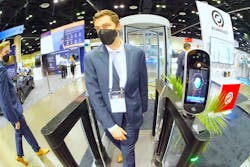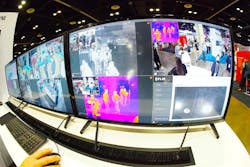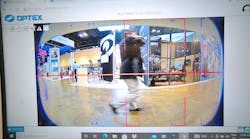The GSX “in-person” tradeshow is back, but things look a little different. Show managers seem to be standardizing on a temperature checkup line for Covid-19 screening, but they also added proof of vaccination as a way to get through the line rapidly.
The power of face-to-face connections was clearly there and exhibitors worked hard to move customers to act by appealing to current trends in access control, personal safety, active assailant detection and perimeter hardening. Moving the show to the southern part of the west concourse inside Orlando’s Orange County Convention Center better fit the smaller footprint of the exhibits. GSX continues the focus that in-person events bring to an exhibitor’s brand, albeit on a smaller scale.
Here are few of the companies I had a chance to visit on day one of the show:
Alvarado
Companies like Alvarado needed face-to-face time to describe unique new product introductions, and with a little time investment, you learned about their first touchless full height turnstile. After presenting a valid entry credential (card or mobile device), an overhead sensor detects the user as they enter, and motorized rotation begins and completes automatically. The result is a smooth and secure, completely touchless entry and exit passage.
Alvarado also showed their low-profile optical turnstile Model 4500 with a compact 38-inch cabinet length, edge-lit crystal-clear swinging light panels with an available lighting package, allowing users to illuminate the side panels and the top and end lights in any RGB color with unique transition effects. It also accepts all types of credential and biometric readers, but Alvarado demonstrated an ultra-fast IDEMIA facial access control device with near-motion, one-second verification through multiple angles and varying light conditions. The IDEMIA VisionPass uses artificial Intelligence and facial recognition algorithms with 2D, 3D, and infra-red cameras, efficient with medical masks, and resistant to all kinds of spoofing attempts.
Bond
Launched in late 2020, the Bond app lets you hire a bodyguard on demand, have a trained, professional security agent live on your smartphone follow your travel progress, check in on a predetermined frequency, or have access to telemedicine and initiate emergency care response. Real estate agents, traveling executives, lone workers, remote workers, commuters, international travelers and family members have access to Bond’s suite of personal security services 24/7 including Ready an Agent, Track Me On the Go, Video Monitor Me, or Send Me a Car. If something doesn’t feel right to you, an agent can be put on standby until you feel safe, or have an agent live, on your mobile device, ready to dispatch law enforcement or a trained agent.
The Bond app lets members order a bodyguard as easily as ordering car service. These Bond agents are, in many cases, former U.S. Secret Service or law enforcement.
The Bond agents also have access to any potentially recurring conditions you wish to share on registration, like epilepsy. For example, an agent was able to determine that a Bond user was no longer moving through a parking garage, and was, in fact, on the ground experiencing a seizure. The agent was able to open the smartphone’s camera, microphone and determine that the user was no longer holding their phone. The agent immediately dispatched EMS through the exact 911 service in the user’s area for faster response. This resulted in medical treatment in minutes, as there were no delays in connecting to an overloaded 911 dispatch center or “good Samaritans” trying to figure out the user’s symptoms or what to do.
With rideshare passengers in danger, a Bond user can simply order a dedicated and trained driver and car from Bond who understands the most expedient way of getting there and back safely, aware of potential carjacking, vehicular terrorism, active shooter threats and gang activity.
Teledyne FLIR
The concept of “mid-range surveillance” is indeed interpretive as FLIR introduces the latest in its Ranger series, the HDC MR, a multi-spectral imaging system (1280 x 720 cooled detector or a 1024 x 576 uncooled detector along with a 1920 x 1080 HD color TV camera) useful in degraded weather conditions, fog and haze (using a fog filter) and through turbulent air with the Merlin ASX turbulence filter.
The range of the available Laser Range Finder is 10 km (mid-range) or 6 km (short-range), complementing the thermal imager’s 5.4°x3.1° narrow and 16.8°x9.3° wide field-of-view (FOV) and 16X digital zoom for the uncooled version. The Color HD imager FOV is ≤2.3°x1.3° narrow and >63°x35° with 30X optical zoom and 12X digital zoom.
The Triton FH-series ID includes seven new models featuring thermal imaging detail and high-performance onboard convolutional neural network (CNN)-based video analytics for both thermal and visible spectra, for classifying human or vehicular intrusions. Retail and transportation professionals have been dealing with an increase of vehicular terrorism and often deadly storefront crashes. This range of models are shock resistant to the MIL-STD-810F "Transportation" Standard, IP66, and De-Icing/Anti-Icing to the MIL-STD-810F, Method 521.1 Standard.
The Triton FH-series complements Teledyne FLIR’s TrafiSense2 V2X, that has a wide range of vehicular detection capabilities, including vehicle and bicycle presence detection, advance pedestrian presence detection, traffic flow monitoring in free flow traffic (counts, occupancy, classification, speeds, headway, gap, level of service), wrong way driver detection and V2X traffic signal priority. V2X means vehicle-to-everything to transportation professionals and smart city build-outs, a significant opportunity for security integrators to grow their business. V2X is already in rapid 64.6% annual growth in the UAE, Singapore and the rest of APAC, driven by demand for fully autonomous driving, 5G technology and increased electric vehicles (EV) sales, government regulations to curb emissions, and need to reduce traffic congestion. The U.S. is expected to commence rapid V2X growth in about two years, through 2030, when the first city without traffic signals is projected.
FLIR’s new Elara R-Series are compact ground radar modules that provide advance warning of both human and vehicle intrusions beyond the perimeter, can continuously tracking and precisely locate multiple targets and support slew and cue for PTZ cameras.
Hanwha Techwin
One of the widest range of product introductions at GSX came from Hanwha Techwin, which featured a lineup of IP-based audio compact speakers, audio/video compact entry devices, vehicle-specific, Road-AI IP cameras, a cloud-based video management system, PoE extenders, AI-based Forensic Search, and X-Series Core and Plus Cameras.
The intercom station also features echo cancellation, noise reduction and a built-in tamper switch and relay for standalone door access. Users can program audio messages to be played automatically when the device is approached or when a call is initiated. Analytics include line crossing, loitering and object appear/disappear.
As a powerful first step into V2X, Hanwha’s new Wisenet Road AI Solution includes Automatic License Plate Recognition (ALPR) cameras that feature make, model, color recognition and EdgeAI. Real-time viewing, event monitoring, forensic search and a range of widgets and graphs that display daily/weekly/monthly traffic statistics.
EdgeAI is a combination of edge computing and artificial intelligence, where AI algorithms are processed locally, directly on the IP camera. The algorithms use video, audio and metadata and allow the camera to make decisions in a matter of milliseconds without having to connect to a server or cloud.
Vehicle classifications include passenger car, SUV, van, light commercial vehicle, truck, bus and motorcycle. In addition, forensic search terms include the following attributes: date/time, license plate, photo, type, brand, model and color. For a single gate entrance, The EdgeAI camera records up to 10,000 vehicle records with full attributes and images.
The X-Core AI and X-Plus AI series cameras detect and classify people, vehicles, faces, license plates, reliably identifying multiple distinct objects. False alarm reduction, improved operator support, forensic search and business intelligence round out the goals of the X-Series. False alarms due to wind-blown trees, shadows, or animals are significantly reduced.
With AI-based object detection, WiseStream III adjusts the encoded video in the X-Core AI and X-Plus-AI to apply maximum video quality on a scene’s detected objects while scaling back encoding elsewhere. When combined with H.265 compression, this user-adjustable feature can provide data reduction of up to 80% depending on the environment and scene motion. The X-Plus AI also supports 120fps for smooth motion capture.
For cybersecurity certification, the X-Plus AI is FIPS 140-2 certified and includes the X-Plus Trusted Platform Module (TPM 2.0).
Eagle Eye Networks and Hanwha Techwin have partnered to create Wisenet Sky, Hanwha Techwin’s first cloud-based solution that supports the X-Series cameras. Wisenet Sky Network Switchers complete the cloud-based infrastructure.
Another new product introduction, Hanwha’s PoE Extenders support longer distance 4 Watt PoE IP devices like the X-series IP cameras, the TID-600R 2MP IR IP Video Intercom, and TCIS-2 outdoor vandal resistant IP audio intercom.
The final new product introduction could be very significant as Hanwha has introduced their first outdoor/indoor 4K IP dome camera (ONV-9081R) and outdoor 4K bullet IP camera (ONO-9081R) supporting the Azena OS (formerly Security and Safety Things). With an Application Store including approximately over 100 apps like Face Mask Detection, FaceBiometricsPro, Gun Detection Real App, and AI Violation, Hanwha Techwin joins an expanding ecosystem designed with users in growth markets in mind: smart cities, commercial buildings, aviation, retail, hospitals, stadiums, railways, borders, critical infrastructure, and traffic monitoring.
Evolon
Formerly Jemez technologies, Evolon introduced a unique edge AI application for compatible Axis Communications fixed and PTZ cameras where an object of interest is acquired in the field of view (FOV) of the fixed camera, that directly communicates a slew, cue and follow command to the PTZ camera. A personEditor's note: Be sure to check out Steve Surfaro's Tech Notes from Day 2 of the show here:
About the Author:
Steve Surfaro is Chairman of the Public Safety Working Group for the Security Industry Association (SIA) and has more than 30 years of security industry experience. He is a subject matter expert in smart cities and buildings, cybersecurity, forensic video, data science, command center design and first responder technologies. Follow him on Twitter, @stevesurf.












